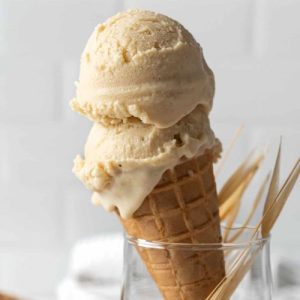
Hazelnut Ice Cream
A creamy, dreamy hazelnut ice cream that’s simple to make yet rich in flavor. No soaking or steeping — just smooth hazelnut butter blended into a custard base. High in plant-based protein and healthy fats, this treat is perfect for everyday indulgence or special gatherings.
Equipment
- 1 high-power food processor
- 1 medium saucepan
- 1 large mixing bowl
- 1 handheld whisk
- 1 wooden spoon
- 1 sifter
- Cling film
- Ice cream machine with inner bowl
Ingredients
- 200 g 1 ½ cups toasted skinless hazelnuts
- 6 large egg yolks
- 130 g ⅔ cup granulated sugar
- 750 ml 3 cups whole milk
- 125 ml ½ cup heavy cream
- 1 teaspoon vanilla extract
- 2 –3 pinches salt
Instructions
- Preparing Hazelnut Butter: Place the toasted, skinless hazelnuts into the bowl of a high-powered food processor. Blend them at high speed, pausing occasionally to scrape down the sides with a spatula. Continue processing until the nuts transform into a smooth, creamy butter with no large pieces remaining. This step intensifies the nutty flavor and creates a perfect base for the custard. Set aside the hazelnut butter for later use.
- Whisking Egg Yolks and Sugar: In a large mixing bowl, combine the egg yolks and granulated sugar. Whisk vigorously using a handheld whisk until the mixture becomes pale, thick, and smooth. This process ensures sugar dissolves completely and creates the foundation for a rich custard. Set the mixture aside while you prepare the dairy base.
- Combining Dairy and Flavorings: Pour the whole milk and heavy cream into a medium saucepan. Add the prepared hazelnut butter, vanilla extract, and a pinch of salt. Stir gently until all ingredients are well combined. Heat the mixture over medium heat, stirring occasionally to prevent sticking. Do not allow the mixture to boil; the goal is to infuse the flavors gently and evenly.
- Tempering the Egg Mixture: Once the dairy mixture is warm, take about one cup and pour it slowly into the egg yolk mixture while whisking constantly. This gradual process — known as tempering — prevents the yolks from curdling. Once fully combined, pour the tempered egg mixture back into the saucepan with the remaining dairy base, stirring continuously for even blending.
- Cooking the Custard: Reduce the heat to low and cook the custard gently. Stir constantly with a wooden spoon or silicone spatula to prevent sticking or curdling. Continue until the custard thickens and coats the back of the spoon — this is called the “nappe” stage. Test by running your finger across the back of the spoon; the line should remain clear. This step ensures a smooth, luxurious texture.
- Straining the Custard: Remove the custard from heat and pour it through a fine mesh sieve into a clean mixing bowl. Use the back of a wooden spoon to press the mixture through, ensuring any lumps or curdled bits are removed. This creates a silky-smooth custard, essential for perfect ice cream. Discard any solids left behind.
- Cooling and Chilling the Custard: Cover the surface of the custard with cling film, ensuring it touches the custard directly to prevent skin formation. Allow it to cool to room temperature. Transfer the bowl to the refrigerator and chill thoroughly — ideally overnight. This deepens the flavor and improves texture when churning.
- Preparing the Ice Cream Machine: While the custard chills, prepare your ice cream machine following the manufacturer’s instructions. Place the inner bowl in the freezer for at least 12 hours so it’s completely frozen. This step is essential for achieving smooth, creamy ice cream.
- Churning the Ice Cream: Pour the chilled custard into the frozen inner bowl of your ice cream machine. Turn the machine on and churn for approximately 30 minutes or according to manufacturer instructions. The custard will thicken and transform into a creamy ice cream.
- Serving and Storing: Serve immediately for a soft-serve texture, or transfer the ice cream into an airtight container and freeze for 1–2 hours for firmer scoops. Store any leftovers in a sealed container in the freezer for up to one week. Before serving, allow ice cream to soften slightly at room temperature for easier scooping.
Notes
- Always use freshly toasted, skinless hazelnuts for the best flavor. You can toast them in a dry skillet or oven before starting.
- Use a high-power food processor for smooth hazelnut butter — a less powerful one may struggle to blend fully.
- Tempering the eggs is essential to avoid curdling, so add the warm milk mixture slowly while whisking constantly.
- Chilling the custard overnight deepens the flavor and ensures creamier texture when churning.
- Store leftover ice cream in an airtight container to avoid freezer burn and maintain freshness.